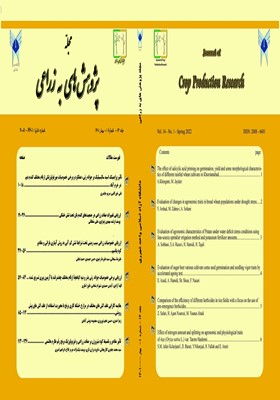Effect of nitrogen amount and splitting on agronomic and physiological traits of rice (Oryza sativa L.) var. Tarom Hashemi
Subject Areas : Crop Production ResearchS.M Jafari 1 , داوود Barai 2 * , یوسف Niknejad 3 , هرمز Fallah 4 , ابراهیم Amiri 5
1 - Ph.D
2 - Assist proff
3 - Assist Proff
4 - prof Assist
5 - Proff
Keywords: Productivity, Rice, Paddy field ecosystem, Nitrogen utilization efficiency,
Abstract :
The experiment was conducted to investigate the response of rice crop plant to nitrogen management in in different geographical regions in northern Iran as factorial based on a Randomized Complete Block Design (RCBD) with three replications in Mazandaran province (Band pay Babol and Babol Plain) and Guilan province (Lahijan region) during 2019 and 2020. Three levels of nitrogen fertilizer including 50, 90 and 130 kg N ha-1 from urea sources were used as main plots and three levels of nitrogen splitting in basal applied, initial heading stage and full heading stage were used as sub plots. The findings revealed that grain yield in Lahijan region (6044 kg ha-1) was 6.57% and 5.53% lower than Band pay region and Babul Plain. With increase of 90 and 130 kg N ha-1 compared to 50 kg N ha-1, panicle length, number of panicle per hill, number of spikelet per panicle, filled spikelet percentage, grain nitrogen uptake, protein yield and nitrogen harvest index (0.77% and 2.44%, respectively) were significantly enhanced which resulted in enhance of grain yield (24.87% and 12.71%, respectively). GY with application of 50, 90 and 130 kg N ha-1 was 5602, 6314 and 6995 kg ha-1, respectively. In contrast, nitrogen utilization efficiency (108.21% and 30.37%, respectively) and nitrogen uptake efficiency (26.02% and 16.53%, respectively) were significantly decreased. Therefore, nitrogen management in the paddy field could be an effective approach to enhance performance of rice and nitrogen utilization efficiency is a major objective of future.
_||_

